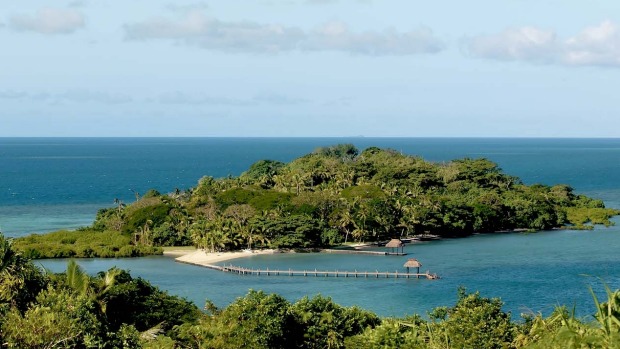
I'll be blunt, 2014 was a crappy year for our family, with loved ones lost and the distances separating those of us remaining felt keenly.
I needed low-fuss nurturing, the chance to reconnect with my private thoughts and to reconstruct a life without someone who'd been there from the moment I was born.
The doctor prescribes meditation and contemplation, the world-map dartboard prescribes Dolphin Island, at the very tip of Fiji's main island, Viti Levu.
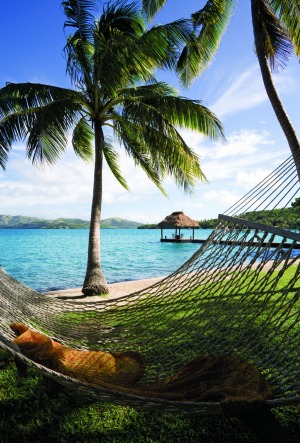
When you book the island, you get the island, and selfishness is indulged: you won't be sharing any of your island paradise with other guests. So I'm travelling with my daughter (3½) and my mum (of a certain age).
We arrive at the nearest town, Rakiraki, emotionally bruised and battered, and the skies weep with us. In fact, the weather may be a little too dramatic.
Normally, Dolphin Island's little boat meets you at Ellington Wharf to take you onto the island, but we are diverted to the nearby four-star, Antipodean-run Wananavu resort, whose sturdy dive boat and more sheltered, private harbour makes for smoother sailing.
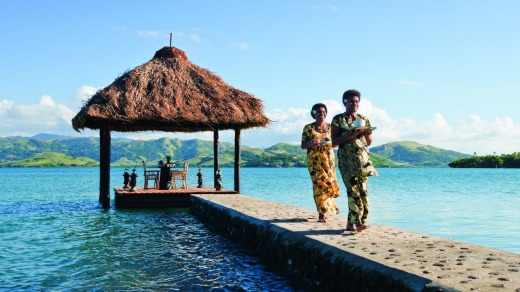
Not that it's a journey of hardship, with frostbite or mouldy rations: the trip out to Dolphin Island takes about six minutes. Ten if it's choppy. And it arrives just in time for lunch.
Dawn, the island's manager, is waiting for us on the jetty, frangipani salusalus (garlands) in hand, smile on face, arms wide open. And she knows we would like to eat Fiji's national dish, kokoda.
She bustles us straight up to the table on the deck, overlooking the pool. The kokoda – raw fish marinated in lemon juice and coconut milk – is served alongside a dish of buttery, garlicky prawns, rice garnished with zest of kumquat and a vivid fruit platter.
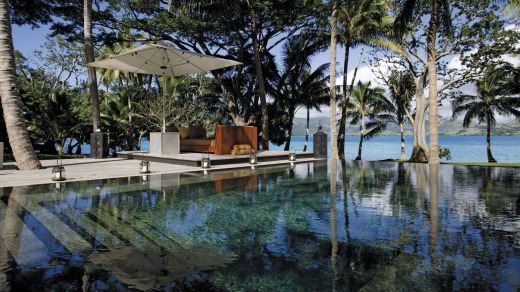
Watermelon juice appears magically for Miss Three, and mum's protestations against drinking wine at lunchtime ("No, I never…") are washed away in a small sea of sauvignon blanc.
"You have to watch out for Bunny," warns Dawn, of the pourer's heavy hand. Chef Bunny grins wickedly from inside the spotless kitchen.
At first glance, there's not a lot to do on the 5.6-hectrare island but eat and languish by the pool or beach. The staff-to-guest ratio is wildly high, running at about two-to-one in our favour, and we already know local mud crabs will make an appearance at dinner. To tide us over in the intermission betwixt two fine meals, sparkling wine and peanuts magically appear to ease any anxiety of starving.
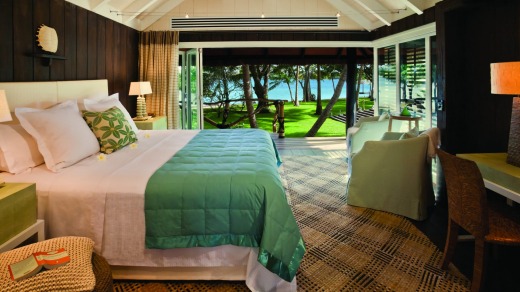
We're so on-trend. Not just because we're staying at Dolphin Island, high up in the world's fabulousness stakes, and the admittedly steep rates would deter many. The buzz-phrase here is "inter-generational travel" and the island is geared toward friends or several generations travelling together.
Really, let's call it what it is: it's a SKI Club (Spending your Kids' Inheritance).
Slowly, the island's character begins to emerge: kayaks and a Hobie Cat are waiting hopefully on the beach, ready to zip out when the poor weather abates.
Quality snorkelling gear hangs from a coconut palm, waiting to be plucked like ripe fruit. Chaise longues languish lazily on sandy strips, just the place to spot gambolling dolphins. And a little path takes the scenic route around the island for a postprandial amble.
At low tide, you can walk the circumference of the entire island. Like the boat trip over, it doesn't take long: around 15 minutes, and that's with a stop at the secret bure.
While the guest accommodation comprises four guestrooms in two lavishly large bures, the secret bure is open to the elements and is hopelessly romantic, a favourite with couples escaping the other (maximum six) guests on the island.
Its four-poster bed is set on a raised platform that looks out through the foliage to Bligh Water, famed for its scuba diving and named for the intrepid Captain Bligh, who nipped through the strait in 1789, allegedly with hot-breathed cannibals hard on his tail.
Back at the main bure, we dine, gossip with Dawn, Lau, Adi and Bunny, and lie slightly comatose after yet another spectacular meal, this time it's ota vakalolo, local ferns cooked in coconut milk, taro leaves, and a range of animals cooked underground in a lovo.
I like to think the food was sweetened by the singing of the villagers who come over to visit and have a little party, with all of us dancing around the towering bonfire, which crashes dramatically at the end.
Yes, the island is exclusive, but it's not opulent in a razzle-dazzle, show-me-the-money kinda way. The deep sofas and furniture are bleached grey and white, the floors covered with traditional hand-woven palm mats and there are fascinating books on Fijian language and history stacked on the low coffee table.
When I lie back to listen to the geckos' chirrups and the shush of the sea, I notice the bure's pitched ceiling is cloaked in Fiji's traditional tapa cloth. It's clear, beautiful and 30 years old, when Huka Retreats' canny owner, Alex van Heeren, bought the island back in 1984.
The island's bures were renovated in 2011 by interior designer Virginia Fisher, who has also lent her magic touch to sister properties Huka Lodge in New Zealand and Grande Provence Estate in South Africa, and Queenstown's too-beautiful Eichardt's Private Hotel.
There are inside showers, there are outside showers. The deep, flower-strewn bath is garnished by a delicate shell chandelier, and looks up into the frangipanis, coconut palms and beyond into the South Pacific skies. Fiji's best toiletries, by Pure Fiji, leave you scented gently of your surrounds – coconut, frangipani or mango.
Opening the white plantation shutters, the view from bed is of the beach and the mountain ridges of the northern-most point of Fiji's main island, and the resting place of Udre Udre, the last known cannibal in Fiji and Guinness Book of Records title holder for "most prolific cannibal".
It's said he'd eaten 999 people, and he didn't like vegetables. Udre Udre died around 1840, but apparently has many descendants living in the Rakiraki area. I am happy to report that today, having guests for dinner is today a far more pleasant experience.
The island is all geared toward providing what is describe as luxury castaway experience: Tom Hanks never had it so good. It's also the antithesis of the kids' club: it's where kids can paddle, float on a bamboo raft, or explore nature in a traditional Fijian way.
My fondest memory is of my small, laughing child, running without a stitch of clothing through the coconut palms to me, as I wait on the beach.
My mum declares the little beach's sand the perfect consistency for making sand castles, and a rope swing hangs from a convenient branch, to let you swing, swing, swing, like you did when you were a child.
After just two nights on the island, it's time to say farewell. Even though we're decamping for a five-star hotel, the crash comes hard.
Who is that person swimming in my pool? Why am I waiting for staff? And how come they don't instinctively know that I wanted kokoda for lunch?
I hate dressing for breakfast and it's tough sharing the resort with several hundred other holidaymakers saying things like, "Wow! This is all so Fijian!" when it is patently obvious it's just the same international chain with a few thatched roofs thrown in.
Our stay with Dolphin Island is brief, but intense. I'm ruined.
FIVE AFFORDABLE FIJI STAYS
Takalana homestay has four bures that suit large, adventurous family groups. An hour north of Suva, it has limited electricity, no TV, but a local dolphin pod. Costs F$115/adult/night. Includes all meals, book early. See fijihomestays.com.
Wananavu Resort, Rakiraki, means "wonderful" in Fijian. On the northern-most point of Fiji's main island, it's 2¼ hours' drive from Nadi airport. There are 34 neat bures and a great pool, no kids' club but plenty of kids' activities and babysitters. From F$273 a night, bure & breakfast. See wananavu.com.
Crusoe's Retreat, Coral Coast is two hours south-east of Nadi, with 28 bures. Neighbouring Namaqumaqua village is home to most staff, with a small school and several churches you can visit. Bures can sleep up to four, from F$232 a night for two adults. See crusoesretreat.net.
First Landing is on Nadi Beach. Its bures have a colonial feel with wide balconies, and can sleep four. The larger bures suit self-caterers and there's an on-site spa. Bures from FJ$235 a night. See firstlandingresort.com.
Barefoot Kuata Island lures those wanting to swim with manta rays. Set amid the Yasawa Islands, opt for a luxury ensuite bure, from FJ$230 a person, a day, includes all meals. See thebarefootcollection.com.
TRIP NOTES
MORE INFORMATION
fiji.travel
GETTING THERE
Fiji Airways flies direct to Nadi from Sydney and Melbourne daily. See fijiairways.com.
STAYING THERE
Dolphin Island costs from $1036 a person, a night, when all four bures are booked with eight guests. Costs from $1400 a person, a night, with just two people on the island. Tariffs include transfers from Nadi, all meals, standard bar and all watersports. It also offers family packages with kids' cooking classes, tapa cloth making and village visits. See dolphinislandfiji.com.